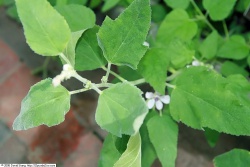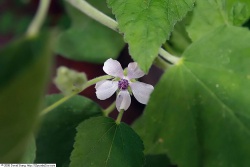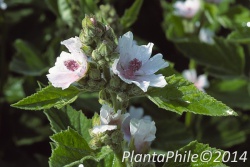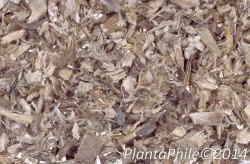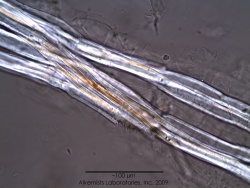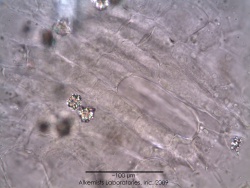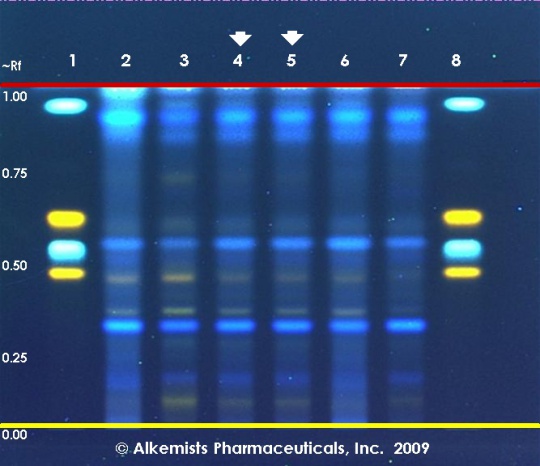Althaea officinalis (root)
(add PlantaPhile references) |
|||
| (12 intermediate revisions by 3 users not shown) | |||
| Line 1: | Line 1: | ||
| − | = | + | {{DISPLAYTITLE:'' Althaea officinalis'' (root) }} {{askbox|herb=''Althaea officinalis''}} |
| − | =Macroscopic | + | =Nomenclature= |
| − | =Microscopic | + | |
| − | {{Microscopy | source=Elan M. Sudberg, Alkemist Laboratories | + | {{nomenclature | binomial=Althaea officinalis |
| + | |authority=L. | ||
| + | |family=Malvaceae | ||
| + | |scn=marshmallow | ||
| + | |syn= | ||
| + | |ayurvedic= | ||
| + | |pinyin= | ||
| + | |aka=althaea; althea | ||
| + | |notes= }} | ||
| + | |||
| + | =Botanical Voucher Specimen= | ||
| + | |||
| + | =Organoleptic Characteristics= | ||
| + | {| border=1 | ||
| + | | | ||
| + | {{Macroscopy | source=United States Dispensatory (1918) | ||
| + | | description="''Althaea officinalis'' ... odor slight; taste sweetish, mucilaginous."}} | ||
| + | |} | ||
| + | =Macroscopic Characteristics= | ||
| + | {| border=1 | ||
| + | | | ||
| + | {{Macroscopy | source=United States Dispensatory (1918) | ||
| + | | description="''Althaea officinalis'' is an herbaceous perennial, with a perpendicular branching root and erect woolly stems, from two to four feet or more in height, branched and leafy towards the summit. | ||
| + | |||
| + | The flowers are terminal and axillary, with short peduncles, each bearing one, two, or three flowers. | ||
| + | |||
| + | The corolla has five spreading, obcordate petals, of a pale rose color. The | ||
| + | fruit consists of numerous capsules united in a compact circular form, | ||
| + | each containing a single seed. | ||
| + | |||
| + | "''Althaea'' is usually cut into small pieces about 5 mm. in diameter, of a uniform grayish-white color and otherwise having the characters of entire roots; occasionally entire, slenderly tapering, attaining a length of 30 cm. and a thickness of 2 cm., externally whitish, longitudinally furrowed, frequently spirally twisted and covered with the somewhat loosened bast-fibers; fracture of bark fibrous, of wood short and granular; internally yellowish-white; bark 1 to 2 mm. thick, porous, due to mucilage cells, and separated from the slightly radiating wood by a distinct, grayish cambium zone..." }} | ||
| + | |||
| + | {{Media4 |cat=Macroscopy | source=MOBOT, Tropicos.org | ||
| + | | source2=MOBOT, Tropicos.org | ||
| + | | mainimage=Althaea officinalis Tropicos 100107288.jpg | ||
| + | | companyimage=TropicosLogo.gif | ||
| + | | companyURL=http://www.tropicos.org/Image/100107288 | ||
| + | | companyimage2=TropicosLogo.gif | ||
| + | | companyURL2=http://www.tropicos.org/Image/100107287 | ||
| + | | image2=Althaea officinalis Tropicos 1000107287.jpg | ||
| + | | reference=Tropicos.org. Missouri Botanical Garden. 06 Aug 2013 <http://www.tropicos.org/Image/100107288>, Tropicos.org. Missouri Botanical Garden. 06 Aug 2013 <http://www.tropicos.org/Image/100107287> | ||
| + | | source3=PlantaPhile | ||
| + | | image3=PlantaPhile - 841.jpg | ||
| + | | companyimage3=PlantaPhile logo.jpg | ||
| + | | companyURL3=http://plantaphile.com/ | ||
| + | |||
| + | | source4=PlantaPhile | ||
| + | | image4=PlantaPhile - 1917.jpg | ||
| + | | companyimage4=PlantaPhile logo.jpg | ||
| + | | companyURL4=http://plantaphile.com/ | ||
| + | | }} | ||
| + | |} | ||
| + | |||
| + | =Microscopic Characteristics= | ||
| + | {| border=1 | ||
| + | | | ||
| + | {{Macroscopy | source=United States Dispensatory (1918) | ||
| + | | description=The powder is whitish; starch grains numerous, from 0.003 to 0.02 mm. in diameter, usually with a long cleft at the point of origin of growth; sclerenchymatous fibers in groups, the walls being quite thick and more or less lignified; trachese with scalariform thickenings or with bordered pores; calcium oxalate crystals few, in rosette aggregates from 0.02 mm. to 0.03 mm. in diameter. }} | ||
| + | |||
| + | {{Media2 |cat=Microscopy | source=Elan M. Sudberg, Alkemist Laboratories | ||
| companyimage= AP-LOGO-Laboratories Crop - Copy.jpg | | companyimage= AP-LOGO-Laboratories Crop - Copy.jpg | ||
| − | | companyURL=http://www.Alkemist.com | + | | companyURL=http://www.alkemist.com |
| + | | source2=Elan M. Sudberg, Alkemist Laboratories | ||
| + | | companyimage2= AP-LOGO-Laboratories Crop - Copy.jpg | ||
| + | | companyURL2=http://www.alkemist.com | ||
| mainimage=Marshmallow Alkemist Laboratories.jpg | | mainimage=Marshmallow Alkemist Laboratories.jpg | ||
| caption1=Bast fibers observed at 400x with Acidified Chloral Hydrate Glycerol Solution. | | caption1=Bast fibers observed at 400x with Acidified Chloral Hydrate Glycerol Solution. | ||
| Line 11: | Line 73: | ||
| caption2=Mucilage bearing parenchyma cells with a rosette of calcium oxalate observed at 400x with Acidified Chloral Hydrate Glycerol Solution. | | caption2=Mucilage bearing parenchyma cells with a rosette of calcium oxalate observed at 400x with Acidified Chloral Hydrate Glycerol Solution. | ||
| characteristics=cellular structures identified in this botanical specimen are bast fibers and the mucilage bearing parenchyma cells with a rosette of calcium oxalate when observed at 400x with Acidified Chloral Hydrate Glycerol Solution. | | characteristics=cellular structures identified in this botanical specimen are bast fibers and the mucilage bearing parenchyma cells with a rosette of calcium oxalate when observed at 400x with Acidified Chloral Hydrate Glycerol Solution. | ||
| + | | reference=Powdered Vegetable Drugs, Jackson, B., 1968 | ||
| }} | | }} | ||
| + | |} | ||
| + | =High Performance Thin Layer Chromatographic Identification= | ||
| + | |||
| + | {{HPTLC | source=Elan M. Sudberg, Alkemist Laboratories | ||
| + | | description=Marshmallow (root) (''Althaea officinalis'') | ||
| + | | companyimage=AP-LOGO-Laboratories Crop - Copy.jpg | ||
| + | | companyURL=http://www.alkemist.com | ||
| + | | mainimage=Althaea_officinalis_-_Alkemists_Laboratories.jpg | ||
| + | | caption1=''Althaea officinalis'' HPTLC ID - Natural Product Reagent + PEG UV 365 nm | ||
| + | | stationaryphase=Silica gel 60, F254, 10 x 10 cm HPTLC plates | ||
| + | | mobilephase=ethyl acetate: glacial acetic acid: formic acid: water [10/1.1/1.1/2.4] | ||
| + | | prep=0.5 g + 5 mL MeOH sonicate/heat @ 50°C ~ 1/2 hr, cntrfg, evap w N2, qs 1mL MeOH | ||
| + | | detection=Natural Product Reagent + PEG -> UV 365 nm | ||
| + | | lanes= Lanes, from left to right (Track, Volume, Sample): | ||
| + | # 1 μL Caffeic acid, Chlorogenic Acid, Hyperoside, Rutin ~0.1% in CH3OH | ||
| + | # 3 μL ''Althaea officinalis''-1 (root) | ||
| + | # 3 μL ''Althaea officinalis''-2 (root) | ||
| + | # 3 μL ''Althaea officinalis''-3 (root) | ||
| + | # 3 μL ''Althaea officinalis''-3 (root) | ||
| + | # 3 μL ''Althaea officinalis''-4 (root) | ||
| + | # 3 μL ''Althaea officinalis''-5 (root) | ||
| + | # 1 μL Caffeic acid, Chlorogenic Acid, Hyperoside, Rutin ~0.1% in CH3OH | ||
| + | |||
| + | Reference materials used here have been authenticated by macroscopic, microscopic &/or TLC studies according to the reference source cited below held at Alkemists Pharmaceuticals, Costa Mesa, CA. | ||
| + | |||
| + | | reference=British Herbal Pharmacopoeia, 1996 | ||
| + | | }} | ||
| + | |||
| + | =Supplementary Information= | ||
| + | =Sources= | ||
| − | + | <references /> | |
| − | + | ||
| − | + | ||
Latest revision as of 23:40, 5 May 2015
Contents |
Nomenclature
Althaea officinalis L. Malvaceae
Standardized common name (English): marshmallow
Botanical Voucher Specimen
Organoleptic Characteristics
|
Macroscopic Characteristics
|
Microscopic Characteristics
|
High Performance Thin Layer Chromatographic Identification
|
Marshmallow (root) (Althaea officinalis) Lane Assignments Lanes, from left to right (Track, Volume, Sample):
Reference materials used here have been authenticated by macroscopic, microscopic &/or TLC studies according to the reference source cited below held at Alkemists Pharmaceuticals, Costa Mesa, CA. Stationary Phase Silica gel 60, F254, 10 x 10 cm HPTLC plates Mobile Phase ethyl acetate: glacial acetic acid: formic acid: water [10/1.1/1.1/2.4] Sample Preparation Method 0.5 g + 5 mL MeOH sonicate/heat @ 50°C ~ 1/2 hr, cntrfg, evap w N2, qs 1mL MeOH Detection Method Natural Product Reagent + PEG -> UV 365 nm Reference see British Herbal Pharmacopoeia, 1996
|
Supplementary Information
Sources
- ↑ United States Dispensatory (1918)
- ↑ United States Dispensatory (1918)
- ↑ MOBOT, Tropicos.org http://www.tropicos.org/Image/100107288
- ↑ MOBOT, Tropicos.org http://www.tropicos.org/Image/100107287
- ↑ PlantaPhile http://plantaphile.com/
- ↑ PlantaPhile http://plantaphile.com/
- ↑ United States Dispensatory (1918)
- ↑ Elan M. Sudberg, Alkemist Laboratories http://www.alkemist.com
- ↑ Elan M. Sudberg, Alkemist Laboratories http://www.alkemist.com
- ↑ Elan M. Sudberg, Alkemist Laboratories http://www.alkemist.com
